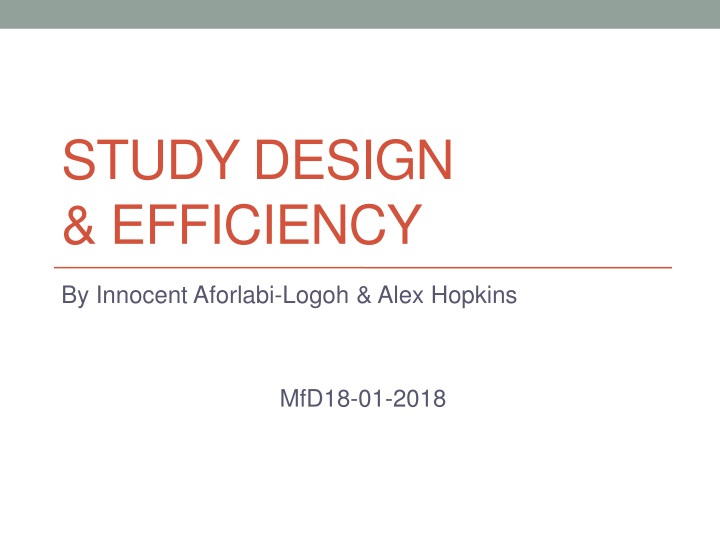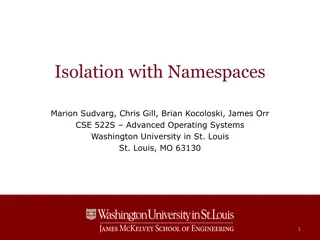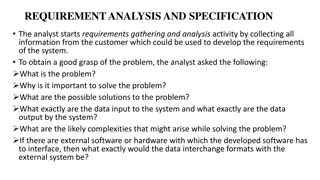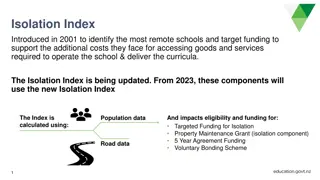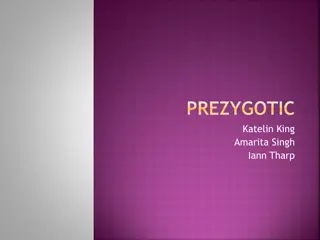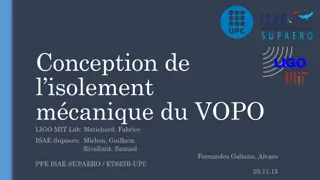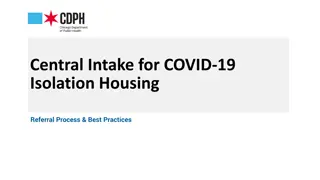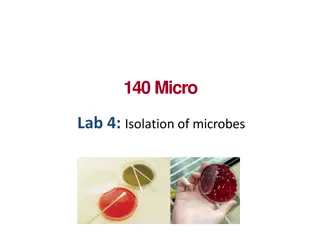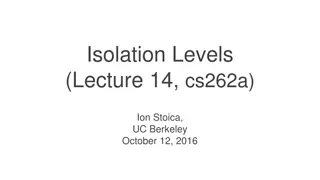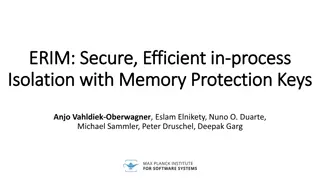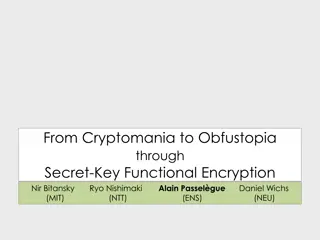Efficient Study Design Methods for Functional Processes Isolation
Focus on isolating functional processes of interest in study designs to maximize BOLD signal contrast, avoid confounding artifacts, and collect comprehensive data. Explore various study design strategies like Subtraction, Conjunction, Factorial, Parametric, and different stimulus presentation approaches. Understand the challenges and solutions in implementing these designs effectively.
Download Presentation

Please find below an Image/Link to download the presentation.
The content on the website is provided AS IS for your information and personal use only. It may not be sold, licensed, or shared on other websites without obtaining consent from the author.If you encounter any issues during the download, it is possible that the publisher has removed the file from their server.
You are allowed to download the files provided on this website for personal or commercial use, subject to the condition that they are used lawfully. All files are the property of their respective owners.
The content on the website is provided AS IS for your information and personal use only. It may not be sold, licensed, or shared on other websites without obtaining consent from the author.
E N D
Presentation Transcript
STUDY DESIGN & EFFICIENCY By Innocent Aforlabi-Logoh & Alex Hopkins MfD18-01-2018
Goal of design Isolate functional processes of interest BOLD signal is relative choose stimulus conditions and timings that maximise BOLD signal contrast Avoid confounding physiological and psychological artifacts Collect as much data as possible Measure behaviour Based on Huettel (Chapter 9)
Study Design Overview Subtraction Conjunction Factorial Parametric Stimulus presentation strategies Blocked Event-related Mixed
Subtraction Two task conditions differing in the process of interest Task condition 1: evokes process of interest Task condition 2: evokes all but the process of interest Challenge -> Finding a good control task Assumption of pure insertion Two (or more) conditions can be cognitively added with no interactions among the cognitive components of a task (Amaro & Barker, 2006)
Problem with Subtraction Example (taken from Friston et al., 1996) V5 activation in response to motion; enhanced by selectively attending to motion. Imagine an experiment -> Motion presented with and without selective attention -> Found V5 activation! -> Conclude V5 role in selective attention for motion (when it actually represents an interaction)
Conjunction Isolate process of interest by finding commonalities between task conditions Task pair 1: subtraction isolating A & B Task pair 2: subtraction isolating A & C A = process of interest For example: Which structure support selective attention network regardless of sensory modalities? Task pairs: Visual stimulus with/without selective attention Auditory stimulus with/without selective attention etc
Conjunction Subtraction Conjunction A = activation task; B = baseline task; PI = process of interest Minimise baseline problem with subtraction Area identified = jointly significant in all subtraction pairs & not significantly different (discounts interaction) Too conservative? (Price & Friston, 1997)
Factorial Two or more variables (or factors) and the different levels of each variable are matched Test for interactions explicitly perform a task where the cognitive components are intermingled in one moment, and separated in another instance of the paradigm (Amaro & Barker, 2006) 2 factors x 2 levels = 4 conditions
Slides from 2016 SPM course Subtraction approach Is the inferotemporal region implicated in object recognition and phonological retrieval during object naming? (Friston et al., 1997) [1] Say yes when you see an abstract image (visual analysis, speech) Results: [2] Say yes when you see an object (visual analysis, speech, object recognition) [1] [2] [3] [3] Name the object (visual analysis, speech, object recognition, phonological retrieval) Assumes object recognition activates IT to the same degree independent of phonological retrieval Subtraction: [2] [1] = object recognition [3] [2] = phonological retrieval
Slides from 2016 SPM course Factorial approach Vary object recognition & phonological retrieval independently Add condition: [4] Name the colour of the presented shape (visual analysis, speech, phonological retrieval) Main effect: Object recognition Phonological retrieval Interaction: IT responses (to object recognition) change depending on the presence of phonological retrieval
Parametric Based on the idea that cognitive demand of task vary systematically with BOLD signal Incrementally increase difficulty of task; relate to BOLD signal Allow dissociation between areas functionally associated with task & other maintenance areas e.g. Working memory task (Seidman et al., 1998) Baseline: respond to all letters Task 1: respond if A preceded by Q (e.g. QA) Task 2: respond if A preceded by Q, separated by three letters (e.g. QrctA) However, other circuits may be recruited at higher cognitive demand
Summary Amaro & Barker (2006)
Study Design Overview Subtraction Conjunction Factorial Parametric Stimulus presentation strategies Blocked Event-related Mixed
Presenting stimulus How to present your stimulus? Detection: knowing which voxel is active (spatial resolution) Estimation: time course of active voxel (temporal resolution) Petersen & Dubis (2012)
Block design Alternating between task conditions e.g. [ Task A rest Task B rest Task A rest Task B rest ] Strong detection/statistical power Maximise data variability due to experimental manipulation (between-conditions variability) Minimise other sources of data variability (within-conditions variability) However Insensitive to shape and timing of hemodynamic response Expectancy effect Based on Huettel (Chapter 9)
Event-related design Evoke process of interest transiently by brief presentation of individual stimuli Task order randomised Better estimation of HRF shape and timing Allow trial-by-trial sorting based on subject response (e.g. subsequent memory effect) However Evoke smaller changes in BOLD signal Larger switching cost between tasks? Based on Huettel (Chapter 9)
Mixed designs Combination of blocked and event-related designs Stimulus present in regular blocks; >1 types of events per block Analysis of IVs on different time scale Block -> state-related processes (e.g. attention) Event -> item-related processes (e.g. button press) Example of a mixed design: Within task block, subject pressed button in response to infrequent target circles, ignoring non-target square. Memory retrieval: Donaldson et al. (2001) found brain areas associated with retrieval mode (state) and retrieval success (item).
References SPM course slides (2016) Scott A. Huettel. (2004). Functional Magnetic Resonance Imaging. Chapter 9. Friston, K. J., Price, C. J., Fletcher, P., Moore, C., Frackowiak, R. S., & Dolan, R. J. (1996). The trouble with cognitive subtraction. NeuroImage, 4(2), 97 104. Price, C. J., & Friston, K. J. (1997). Cognitive conjunction: a new approach to brain activation experiments. NeuroImage, 5(4 Pt 1), 261 70. Amaro, E., & Barker, G. J. (2006). Study design in fMRI: Basic principles. In Brain and Cognition (Vol. 60, pp. 220 232). Seidman, L. J., Breiter, H. C., Goodman, J. M., Goldstein, J. M., Woodruff, P. W., O Craven, K., et al. (1998). A functional magnetic resonance imaging study of auditory vigilance with low and high information processing demands. Neuropsychology, 12, 505 518. Petersen, S. E., & Dubis, J. W. (2012). The mixed block/event-related design. NeuroImage. Donaldson, D. I., Petersen, S. E., Ollinger, J. M., & Buckner, R. L. (2001). Dissociating state and item components of recognition memory using fMRI. NeuroImage, 13(1), 129 142.
General advices For group-level inference larger sample sizes are better If you have 40 hours of scanning: rather 40 person 1 hour than 10 person 4 hours Run each scan as long as possible (40-60 min) Keep subject as busy as possible Fewer conditions/contrasts are better Efficiency is not the same for every contrast!!!!! (optimize efficiency for the most important contrast)
Technical considerations A good fMRI experiment needs 2 things: 1. Induce subject to do or experience the psychological state that you want to study (psychological) 2. Effectively detect brain signals related to those psychological states (statistical) You can have a great psychological experiment with huge neuronal response, but be completely unable to detect this in fMRI-signal
Reminder GLM General Linear Model: Y = X . Data Design Matrix Parameters error + Efficiency(e) is the ability to estimate , given the design matrix (X) for a particular contrast (c) and the given noise variance ( 2) e (c, X) = inverse ( 2cTInverse(XTX) c) 1. The efficiency for each contrast is different 2. We can calculate the efficiency just based on the contrast and design matrix before we have seen any data!
BOLD response HRF The relation between a burst of neuronal activity and the BOLD signal is captured by Haemodynamic Response Function (HRF) Peak Undershoot 2 difficulties for design timing: BOLD response is very sluggish Low frequency drifts in fMRI signal, need to be filtered out by high-pass filter Rik Henson s SPM guide: http://imaging.mrc-cbu.cam.ac.uk/imaging/DesignEfficiency Alessandro G. Allievi et al. Cereb. Cortex 2015
Fixed stimulus onset asychrony (SOA)= 16s Detection of signal in background noise works best if variability of neural signal is maximised Signal that varies little will be difficult to detect not particularly efficient design To obtain predicted fMRI time series: Convolve stimulus function with a haemodynamic response Rik Henson s SPM guide: http://imaging.mrc-cbu.cam.ac.uk/imaging/DesignEfficiency
Fast event presentation-> not efficient Fixed SOA 4s HRF Low variance cannot contrast with baseline Signal lost after high-pass filtering
Stochastic and blocked event presentation ->very efficient Random SOA minimum 4s e.g. event-related: larger variability in signal HRF Blocked, SOA 4s: larger variability in signal HRF
Fourier Transformation FT converts time function into sum of sine waves of different frequencies represent signal in frequency space FT helps to see which components will pass the HRF filter
Most efficient design The optimal design would be to modulate the neural activity in a sinusoidal fashion (e.g, sinusoidally varying the luminance of a visual stimulus), with a frequency that matches the peak of the amplitude spectrum of the IR filter This places all the stimulus energy at this single frequency, shown by the single line in frequency
Stochastic design -> efficient Stochastic designs spread frequency energy across wide range of frequencies, from which much is passed through
High-pass filtering Low frequency noise in fMRI (e.g. scanner drifts) High-pass filter cut-off in SPM 0.01Hz (100s) Don t design blocks of too much length (not longer than 50 sec), because high pass filtering would remove most of the signal Don t contrast conditions too separate in time High-pass filter
2 OR MORE CONDITIONS Things get more complicated .
Different efficiency for different contrasts Randomiseddesign 2 events: Common effect e.g. faces vs baseline Differential effect e.g. sad vs happy faces Optimal SOA for main effect (A+B): long SOA Optimal SOA for differential effect (A-B): short SOA Rik Henson s SPM guide: http://imaging.mrc-cbu.cam.ac.uk/imaging/DesignEfficiency Trade off!
Timing: Null events Convenient way of creating a stochastic design by randomising the SOA between the components of interest (A-B) Efficiency Null events not different from baseline (A+B) Efficient for main AND differential effects at short SOAs reduces trade off between contrasts SOA (s) Rik Henson s SPM guide: http://imaging.mrc-cbu.cam.ac.uk/imaging/DesignEfficiency
Jitter or Null-events for good trade-off Introduce Null-events helps to estimate the baseline-> better efficiency for main effect (A+B) (A-B) Efficiency Not real events do not differ from baseline and are not detectable by subjects (A+B) Efficient for differential and main effects at short SOA SOA (s)
Correlation between regressors Fixed SOA Jittered SOA Fixed with half of trials High correlation between regressors can reduce efficiency If 2 events (e.g. stimulus and response) are highly correlated, you can t determine which of both caused the BOLD signal
Conclusion Optimal design for one contrast might not be optimal for another Block design (short block length ~16sec) are most efficient Block designs are often psychological not possible: stochastic designs with jittered SOA or null-events are also very efficient Don t have too long blocks/ contrast too separate in time, since it will be filtered out by high-pass filter
References SPM course slides (2016) Scott A. Huettel. (2004). Functional Magnetic Resonance Imaging. Chapter 9. Friston, K. J., Price, C. J., Fletcher, P., Moore, C., Frackowiak, R. S., & Dolan, R. J. (1996). The trouble with cognitive subtraction. NeuroImage, 4(2), 97 104. Price, C. J., & Friston, K. J. (1997). Cognitive conjunction: a new approach to brain activation experiments. NeuroImage, 5(4 Pt 1), 261 70. Amaro, E., & Barker, G. J. (2006). Study design in fMRI: Basic principles. In Brain and Cognition (Vol. 60, pp. 220 232). Seidman, L. J., Breiter, H. C., Goodman, J. M., Goldstein, J. M., Woodruff, P. W., O Craven, K., et al. (1998). A functional magnetic resonance imaging study of auditory vigilance with low and high information processing demands. Neuropsychology, 12, 505 518. Petersen, S. E., & Dubis, J. W. (2012). The mixed block/event-related design. NeuroImage. Donaldson, D. I., Petersen, S. E., Ollinger, J. M., & Buckner, R. L. (2001). Dissociating state and item components of recognition memory using fMRI. NeuroImage, 13(1), 129 142. https://mediacentral.ucl.ac.uk/Player/2897 https://www.coursera.org/learn/functional-mri-2/lecture/zVWBb/module-7a-advanced- experimental-design-i-fundamentals-of-design-efficiency http://imaging.mrc-cbu.cam.ac.uk/imaging/DesignEfficiency
